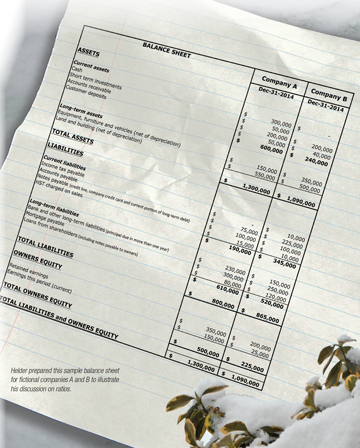August 29, 2016
Understand the balance - Part 2
Resist the urge to ignore financial ratios.
They are the guideposts to success — however you choose to define it.
BY LEE ANN KNUDSEN
Note: This story builds on Understand the balance, from the June 2015 issue of Landscape Trades. Read it at www.landscapetrades.com/balance-2.
According to Nathan Helder, balance sheets are all about relationships. Understanding how the asset and liability line items within your business relate to each other is key to guiding your business toward your ultimate goals.

Helder is president of Gelderman Landscape Services, Waterdown, Ont. He is enthusiastic about applying financial management principles to the landscape industry. Helder also helps business owners from any sector improve financial position through his company Southbrook Consulting.
Are your assets paying off?
There is no question, a shiny new four-by-four excites the emotions. But Nathan Helder encourages business owners to look at trucks, other equipment and assets as components of numbers in your balance sheet. The Return on Assets Ratio expresses what your assets do for you as a percentage. This ratio is very important for landscape companies, as it measures how effectively your company uses your total invested equipment capital.
Return on Assets Ratio = Net Profit ÷ Total Assets
- Company A has $150,000 in net profit divided by $1,300,000 in total assets, for a Return on Assets Ratio of 11.5 per cent
- Company B has $25,000 in net profit divided by $1,090,000 in total assets, for a Return on Assets Ratio of 2.3 per cent
Higher-risk sectors of the green industry should expect a higher ROA ratio. After all, higher return goes hand-in-hand with higher risk. Helder sets a benchmark ROA ratio for design/build/maintenance contractors also offering snow management at 25 per cent. His benchmark for companies that do maintenance and snow only is 20 per cent, while contractors that do only design and construction should have a 30 per cent Return on Assets ratio.
Is your investment paying off?
The Return on Equity ratio is one step up in importance from the asset ratio above. It looks at your whole company, and quantifies return on the money invested in your business.
Return on Equity Ratio = Net Profit ÷ Owner’s Equity (Total Net Worth)
- Company A has $150,000 in net profit divided by $500,000 in total owner’s equity, for a Return on Equity Ratio of 30 per cent
- Company B has $25,000 in net profit divided by $225,000 in total owner’s equity, for a Return on Equity Ratio of 11.1 per cent
Where do we go from here?
Helder approaches numbers with lots of energy, and projects a sincere desire to help other landscape companies prosper. His first recommendation is to actually study your balance sheet monthly or quarterly — always keeping an eye on key ratios. This is not about the size of your numbers; your Income Statement (P&L) reveals revenue and expense trends. Rather, the relationships shown in your balance sheet indicate the direction your whole company is taking.
When asked whether the balance sheet shows if a business is growing, Helder fired back, “What does growth mean? Is it more revenue, or better net profit? Or does it mean you are building more infrastructure for security? Growth, like success, can have different meanings for different business owners.”
Helder says strategic thinking, based on what your balance sheet reveals, can mean everything for your business. On the one hand, conservative business owners may leave lots of cash in their companies, to build security. But stagnant cash is not producing income, and it may even heighten vulnerability to lawsuits, or worse yet, take your “foot off the gas pedal” and slide backwards.
On the other side of the coin, less fortunate business owners may continue pumping their own funds into a company to keep it afloat; Helder says negative-figure retained earnings are all-too-common. He sees this as a very dangerous financial position, and cautions that things can go bad really fast.
Can a business owner in this situation turn it around? “Sure,” says Helder, “but you have to be really committed, motivated and willing to spend five years or more being tough on yourself and your business.” The biggest hindrance to turning a business around, according to Helder, is pride. He is convinced that if a contractor can get past that ego hurdle, folks will always help. “You are not by yourself.”
Helder says he learned a lot from his predecessor at the helm of Gelderman, Hank Gelderman. He learned that the landscape business is never likely to see huge windfalls, but one should always take out little bits to invest when you can. Building your family’s future outside of your company, as well as within, is smart. “Smart” is what Helder calls people that look to create wealth outside of their business.
He says, “I like the parable of the talents in the Bible. We should be like the servant that took his five talents, and went and traded with them to make ten. Not the servant that buried his talent in the earth. What do we do with our money? Do we spend it on wasteful luxury? Or do we make it grow?
“I like seeing people grow.”